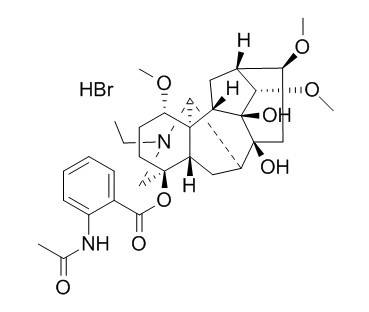Lappaconitine Hydrobromide
Lappaconitine hydrobromide, a diterpene alkaloid, is a drug for the treatment of cardiac arrhythmias, it is a selective blocker of the TTX-sensitive Na+ channels, and does not influence on the activation threshold of Na+ channels. Lappaconitine hydrobromide can be used for local anesthesia, and analgesic treatment. Lappaconitine hydrobromide has anti-inflammatory effects, it can remove inflammation and swelling, lower temperature and relieve heat.
Inquire / Order:
manager@chemfaces.com
Technical Inquiries:
service@chemfaces.com
Tel:
+86-27-84237783
Fax:
+86-27-84254680
Address:
1 Building, No. 83, CheCheng Rd., Wuhan Economic and Technological Development Zone, Wuhan, Hubei 430056, PRC
Providing storage is as stated on the product vial and the vial is kept tightly sealed, the product can be stored for up to
24 months(2-8C).
Wherever possible, you should prepare and use solutions on the same day. However, if you need to make up stock solutions in advance, we recommend that you store the solution as aliquots in tightly sealed vials at -20C. Generally, these will be useable for up to two weeks. Before use, and prior to opening the vial we recommend that you allow your product to equilibrate to room temperature for at least 1 hour.
Need more advice on solubility, usage and handling? Please email to: service@chemfaces.com
The packaging of the product may have turned upside down during transportation, resulting in the natural compounds adhering to the neck or cap of the vial. take the vial out of its packaging and gently shake to let the compounds fall to the bottom of the vial. for liquid products, centrifuge at 200-500 RPM to gather the liquid at the bottom of the vial. try to avoid loss or contamination during handling.
Antioxidants (Basel).2022, 11(8):1471.
Int J Mol Sci.2022, 23(10):5813.
Universite de Bordeaux2017, 2017BORD0867
Prev Nutr Food Sci.2024, 29(4):504-511.
Research SPJ.2024, 0377.
Environ Toxicol.2020, doi: 10.1002
Phytomedicine.2020, 153440.
Plant Physiol Biochem.2021, 160:166-174.
Trop J Nat Prod Res.2019, 3(1):6-9
Cell Prolif.2021, 54(8):e13083.
Related and Featured Products
Yao Xue Xue Bao. 2011 Apr;46(4):432-7.
Pharmacokinetic study of lappaconitine hydrobromide in mice by LC-MS.[Pubmed:
21748973]
A high sensitive and rapid method was developed for the analysis of lappaconitine in mouse plasma using liquid chromatography coupled to mass spectrometry (LC-MS).
METHODS AND RESULTS:
Detection was performed by positive ion electrospray ionization (ESI) in multiple reaction monitoring (MRM) mode, monitoring the transitions m/z 585 --> m/z 535 and m/z 356 --> m/z 192, for the quantification of lappaconitine and tetrahydropalmatine (internal standard, IS), respectively. The method was linear over the concentration range of 3.0-2000.0 ng x mL(-1). The lower limit of quantification was 3.0 ng x mL(-1). Intra- and inter-run precisions (RSD) were both less than 9.9% and accuracy (RE) within +/- 4.8%. After single intravenous injections of Lappaconitine Hydrobromide at 1.0, 2.0 and 4.0 mg x kg(-1), the elimination half-lives (t(1/2)) were 0.47, 0.48 and 0.49 h, and the areas under the curve (AUC(0-t)) were 55.5, 110.5 and 402.9 ng x h x mL(-1), separately. The pharmacokinetic profile of lappaconitine was linear at relatively lower dose levels (1.0-2.0 mg x kg(-1)).
CONCLUSIONS:
When the dose increased farther to 4.0 mg x kg(-1), the Vz and CL decreased, and the increase fold of the AUC was much larger than that of the dose.
Electrophoresis. 2012 Aug;33(16):2577-83.
Simultaneous determination of lappaconitine hydrobromide and isopropiram fumarate in rabbit plasma by capillary electrophoresis with electrochemiluminescence detection.[Pubmed:
22899266]
METHODS AND RESULTS:
A CE electrochemiluminescence (CE-ECL) method for simultaneous determination of Lappaconitine Hydrobromide (LH) and isopropiram fumarate (IF) has been first established, with a chemically modified platinum electrode by europium (III)-doped Prussian blue analogue film as a working electrode. The conditions for CE separation and ECL detection are discussed and optimized in detail. It has been proved that 20 mmol/L phosphate buffer (pH 8.5) containing 5% (v/v) ACN and 0.17 mol/L SDS could achieve the most favorable resolution, and the high sensitivity of detection was obtained by maintaining the detection potential at 1.23 V. Under optimized conditions, a baseline separation for the two analytes was achieved within 6 min, and the standard curves were linear in the range of 1.0×10(-7) ~ 5.0 × 10(-5) g/mL for LH and 4.0 × 10(-8) ~ 1.0 × 10(-5) g/mL for IF with the detection limits (3σ) of 6.6 × 10(-8) g/mL for LH and 3.7 × 10(-8) g/mL for IF, respectively. The precisions of intra- and interday measurements for LH and IF were less than 4.21 and 2.61%, respectively.
CONCLUSIONS:
The applicability of the proposed method was illustrated in the determination of LH and IF in rabbit plasma with recoveries between 95.6 and 103.0%.



